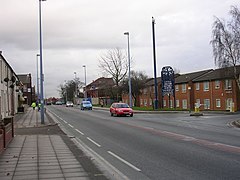Little Hulton
| Little Hulton | |
|---|---|
 Little Hulton |
|
| Little Hulton shown within Greater Manchester | |
| Population | 13,469 Ward profile conducted by Salford City Council in 2014. |
| OS grid reference | SD719037 |
| • London | 170 miles (274 km) SE |
| Metropolitan borough | |
| Metropolitan county | |
| Region | |
| Country | England |
| Sovereign state | United Kingdom |
| Post town | MANCHESTER |
| Postcode district | M38 |
| Dialling code | 0161 |
| Police | Greater Manchester |
| Fire | Greater Manchester |
| Ambulance | North West |
| EU Parliament | North West England |
| UK Parliament | |
Little Hulton is an area of the City of Salford, Greater Manchester, England, 3.4 miles (5.5 km) south of Bolton, 7 miles (11.3 km) west-northwest of Salford, and 9 miles (14.5 km) west-northwest of Manchester. Little Hulton is bordered by Farnworth to the north and Walkden to the east.
A profile of the ward conducted by Salford City Council in 2014 recorded a population of 13,469.
The ancient district of Hulton containing three townships, Over Hulton, Middle Hulton and Little Hulton, was recorded as Helghtun and Hulton in 1235, Hilton in 1278 and 1292, and Hulton in 1292, although Hilton was still used until the 17th century. Historically Little Hulton was a village in the ancient Deane parish with a chapel, sometimes called Peel Chapel. The chief manor was held by the Hultons at Hulton Park in Over Hulton.
Wharton was a subordinate manor that gave its name to the family living there. Later it was owned by the Asshetons of Great Lever and after that the Morts. It was sold to Bridgewater Collieries. Wharton Hall was a two-storey farmhouse built of brick, timber and plaster.
In the 13th century Peel or Wicheves, another district in the township, was owned by the Hultons who sold it to the Tyldesleys. Later it was owned by Edmund Fleetwood of Rossall who sold it to the Morts. Joseph Yates of Manchester bought it in the 18th century and his descendants sold it to colliery owner, Ellis Fletcher of Clifton. Peel Hall was reputedly built in 1840 by Matthew Fletcher, from the designs of Sir Charles Barry. It stood on the site of an older stone-built hall which had a moat. Peel Hall became a sanatorium to treat tuberculosis and subsequently a geriatric hospital until it closed in 1990. It was sold to a development company for refurbishment but, despite being a Grade II listed building, was vandalised, became dangerous and was demolished in the mid-1990s.
...
Wikipedia

